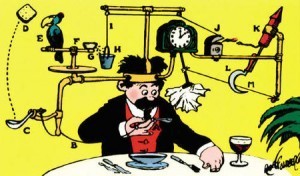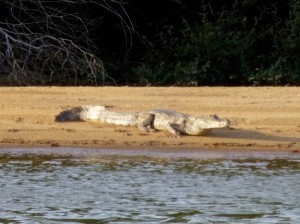Evolution, Extinction, and INVASIVE SPECIES
 “Our civilization is a Rube Goldberg machine spun from sugar.”
“Our civilization is a Rube Goldberg machine spun from sugar.”
One of the best–and most fascinating–things about reading the reviews of Invasive Species is seeing what aspect of the book each reviewer responds most strongly to. Some focus on the science-fiction elements, others on the natural history and hard science, still others on the political battles that drive part of the story.
The above quote, which I love, comes from a review published recently on a blog with the great name of ”a prowl of malcontents.” The author, Ellen Joyce, zeroes in on one of my favorite aspects of the novel: The chance it gave me to dissect the surreal absurdity of the ways we depend on technology for our day-to-day lives, and our belief that somehow that dependence somehow makes us invulnerable.
The brilliant science writer Gordon Grice, in his astonishing book The Red Hourglass: Lives of the Predators, makes a point that most of us miss: Just because a species is more highly evolved doesn’t mean it’s “stronger,” and therefore more likely to avoid extinction. In fact, the reverse is usually true. Highly specialized species come and go, while the simplest models endure.
 For example, Grice points out, crocodilians have been around for 170 million years, yet they still look much as they did at the start: “From the time of the dinosaurs to the present ‘rule’ of humanity,” he writes, “the crocodile has been swimming quietly in rivers and oceans, dining on members of the ruling parties, spilling more royal blood than Richard III.”
For example, Grice points out, crocodilians have been around for 170 million years, yet they still look much as they did at the start: “From the time of the dinosaurs to the present ‘rule’ of humanity,” he writes, “the crocodile has been swimming quietly in rivers and oceans, dining on members of the ruling parties, spilling more royal blood than Richard III.”
Nor are crocodiles alone in this unchanging dominance. Sharks and tarantulas are two nearly identical examples: Big brutes with big mouths and sharp fangs. Predators that basically mug their prey and have been around pretty much the same form for tens of millions of years. And why not? No point in changing something that works so well.
I was thinking of Gordon Grice when I decided to write Invasive Species. The history of life on earth has witnessed one phenomenally advanced creature after another rise…and then fall. No, none of them before us sent satellites into space…but none of them depended on those satellites for most of their most crucial communications needs, either.
In her “a prowl of malcontents” review, Ellen Joyce cheerleads for the end of civilization: “It was a great feeling to watch it all implode, just like I suspect it will someday.” I’m not sure every reader will feel the same way, but I do know that at least some will understand why I think our perch at the top of the pyramid is an unsteady one.
And why the events I created in Invasive Species seemed not only logical to me, but most likely inevitable.
The post Evolution, Extinction, and INVASIVE SPECIES appeared first on Marmaduke Writing Factory.




